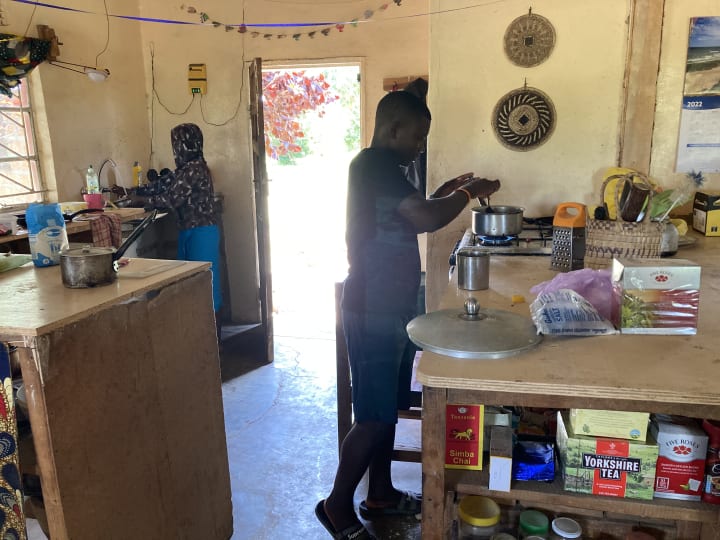Zambia Journal
Part 1-First Impressions and Lunch

I start my story somewhere around the beginning of the middle. It is March in 2022. We are on The Great North Road, in a Land Rover, in Zambia, traveling from the capital, Lusaka, to Fimpulu in Luapula Province near the DRC (Democratic Republic of Congo) border. I am riding with my daughter, one of her bosses, a coworker of my daughter, and her mother. I landed at Kenneth Kaunda International Airport in Lusaka two days previously, after twenty-two hours of flying from JFK in New York and a mid-journey eight-hour overnight layover in Doha, Qatar. The other mother, an American living in Dubai, had just landed after a seven-hour flight.
We picked our way out of the Lusaka area slowly. We passed men on the side of the road pushing extended wheelbarrows full of building supplies and other items and women in their brightly patterned citenge cloth wraps walking with baskets filled with produce on their heads, men on bicycles with bundles of handmade charcoal stacked to a level above their heads and children in uniforms walking home from school. Spaced out along the paved roadway from morning to late into the night, Zambians walk everywhere. In the cities, there are hundreds of people walking. Out in the countryside, there are one or two people every hundred meters or so, their way at night lit only by the moon, the occasional flashlight, or cell phone light.
After the first hour of driving, the congestion of the city gave way to largish farms with tall maize in the fields, then to villages somewhat like film depictions of tumbleweed littered towns of an American Western, then to villages of tiny homes made of large handmade bricks with roofs made of grass or corrugated tin. Hand-painted signs indicated occasional schools or churches lining the road.

The drive from Lusaka to our destination Choshen Farm is a twelve-hour one. It is possible to complete it in ten hours with the right timing and on roads that have not washed out in the heavy downpours of the rainy season. It is my first time as a visitor to any African nation.
As it is the end of the rainy season in March, the grass along the two-lane wide main road is taller than a person. Occasionally it parts to reveal the red dirt surrounding a small village, and we slow for a herd of goats crossing the road or laying on it or for a chicken or two.

After a couple of hours on the road, we reach Kabwe and turn to the northeast. Zambia is a country shaped like two joined fists, one above and to the east of the other. At the top of the westernmost fist, a thin strip of land belonging to the DRC about six miles wide runs south between the two regions. A safe route would cut several hours off the trip; however, the road is reputedly full of bandits, kidnappers, and cutthroats. Every sane person goes around the long way.
My daughter Clara began living and working in Zambia six years ago as a volunteer for the US Peace Corps. The Peace Corps, established by President John F. Kennedy in 1962 at the suggestion of University of Michigan students, has four organized branches. They focus on health and nursing, education (English teachers), aquaculture, and LIFE (Linking Income, Food, and Education), the last of which had been my daughter's focus.
After her initial two-year and three-month stint with the Peace Corps, she applied to work on an extension project at Choshen Farm for two years. The Peace Corps essentially loans out skilled volunteers with specific talents to non-government organizations for a period of up to two years after they finish their initial term of service. My daughter's specific knowledge to qualify her for the post was her two years working with subsistence farmers in a rural location in northern Zambia and her experience with the local language iciBemba also called Bemba. When her extension project was nearing completion, the Peace Corps shut down operations worldwide due to the Covid-19 pandemic. She was transferring her work permit to Choshen Farm for an additional two-year contract so she could complete the transition to stay and work in Zambia for the duration of the US shutdown.
Although Zambia's official language is English, in specific regions around the country up to eight other primary native tribal languages and their dialects are spoken at home and there are a total of seventy-two recognized languages. Outside the capital, it is common to meet people that don't speak fluent English or have no experience with it at all.
Due to our late start from the airport, we pulled into a hotel around eight in the evening. Clara and I shared a room next to the hotel owner's chicken pen until about five in the morning. It was still dark when we got on the road again, our headlights picking up people already walking to work.
By 10 in the morning, we crossed over the 3.5 km long Mukuku Bridge into Luapula province. The land bridge crosses the Lake Bangweulu Swamp, an enormous expanse of grass and water fed by the Luapula River, a tributary of the Congo. It is one of the largest and most important wetlands found in the world and hosts native and migrating birds and rare animals. In addition, the grassland and waterways are essential food and income sources for local inhabitants.
After crossing into Luapula Province, we pulled into the Shop Rite in Mansa an hour or two later to gather provisions at the only large grocery store in the region before driving the last hour to Choshen Farm.
Up to this point, I was still unaware of the to-the-bone lives of most people in Zambia. The Shop Rite was an American-style grocery store, similar to a store you would see in any small town in the US. Outside the parking lot gates, however, women were seated on the ground with piles of bananas, watermelons, tomatoes, and other seasonal fruits and vegetables of the region. After shopping in the grocery store, we went outside to purchase tiny fresh bananas, onions, and watermelon, all grown locally. The watermelon was delicious, especially for someone who had arrived from the late winter weather of New York State.
We piled into the Rover again and continued for the last hour of the trip. We finally turned off the main paved road for the final ten minutes of the trip onto a very washed-out dirt road and arrived in the village of Fimpulu.
Several teenagers were waiting at my daughter's house. A brother and sister duo with permanent access to her house were busy making a traditional style meal to greet us for lunch. Several other teens were there to greet her and eat with us.

I learned a couple of basic phrases in Bemba over the first few days in the capital so I tried out my greetings of "Mulishani" and the correct response of "Bwino." In a Zambian village, it is important to greet everyone you see as you pass, whether walking on the road or outside in front of their homes. Lack of a greeting essentially says you don't view them as a person.
As Clara introduced me to her teen friends, she explained the names of those named in the Bemba language. Bemba names often describe a person's place within their family. Chola is a common first name only given to the child born next after twins. I met two Cholas during my visit. The name of any eldest twin is traditionally Mpundu, and the youngest is Kapya.
Lunch was composed of nshima and a sauce made with tomatoes and onions. We added some sausages we had picked up at the Shop Rite that morning, a rare treat.


Nshima is a staple food of southern African countries. It can be made of cassava root meal, maize meal, or a combination of cassava and maize. This last is the style of nshima served to us at my first village lunch. The cooking technique is to sprinkle the maize meal into a pot of boiling water while constantly stirring. When the porridge begins to thicken, the cassava meal is added and cooked while stirring. The result is then taken off the heat and stirred until it becomes a pliable white pudding-like mass, somewhat like the Italian polenta before baking or stiff cookie dough. It takes some muscle to complete the stirring. The total cooking time for a simple meal starts at about one hour. The flavor is bland but somewhat nutty. The texture is smooth.

Nshima is taken hot directly from a shared pot using the right hand only. The technique is to pull off about two or three tablespoons at once, rolling it several times in the right hand, and dipping it into the sauce or stew with which it is served. The sauces can be made of tomatoes, sweet potato leaves, ground nuts, peanuts, or various other vegetables in season. Meat is a rarity due to its price and the lack of refrigeration but chicken is the most common farmed meat source. In Fimpulu fish is also available since both Choshen Farm and several local farmers maintain fish ponds.
After lunch, Clara settled me into her bedroom, complete with a life-preserving antimalarial mosquito net donated by USAID over the bed, and then took me on my first walking tour of Fimpulu.

*****
Look for future posts about my trip under the heading Zambia Journal.
If you are interested in finding out more about the Peace Corps or Choshen Farm, I have included links to both organizations. Donations to either organization can be directed to the individual project closest to your heart.
Choshen Farm is a 501C3 unaffiliated Christian mission organization. The organization takes a holistic approach to ministry. The work of Choshen Farm focuses on raising local incomes by providing jobs and creating earning opportunities for farmers, raising the quality of life through health education and clean water systems, raising the quality of local elementary education, and providing a retreat center for Zambian pastors and church groups. Oversight is by two boards, a Board of Directors in the United States and a Zambian Board of Directors. The organization was started in 2008 by Jeremy and Bethany Colvin. Both manage and participate in maintaining the organization on the ground in Fimpulu. The village of Fimpulu was originally Bethany's Peace Corps assignment.
https://www.choshenfarm.org/#our-mission
The Peace Corps is a US Government benevolent organization dedicated to the exchange of culture around the world. It seeks to promote goodwill and understanding between US citizens and the citizens of foreign countries that invite its volunteers. In ordinary times, approximately 6,000 US citizens are serving two-year stints in over 60 countries. Many volunteers stay involved in their service locations after returning to the US.
This story was previously published on Medium. https://medium.com/p/336f2a97bf3d
About the Creator
Natalie Wilkinson
Writing. Woven and Printed Textile Design. Architectural Drafting. Learning Japanese. Gardening. Not necessarily in that order.
IG: @maisonette _textiles
Reader insights
Outstanding
Excellent work. Looking forward to reading more!
Top insights
Excellent storytelling
Original narrative & well developed characters
Expert insights and opinions
Arguments were carefully researched and presented
Eye opening
Niche topic & fresh perspectives
Heartfelt and relatable
The story invoked strong personal emotions
Masterful proofreading
Zero grammar & spelling mistakes







Comments (8)
It is great to hear about one of the few countries I have not visited yet.
Great article.
Thank you for sharing, brings me back to traveling Zambia, well done.
The beauty of the journey, thanks for sharing.
Thanks for sharing 😊 It was a great read. All the best and happy writing.
Very interesting..
Thank you for sharing your journey. Very interesting..
Love travel stories! Well done.